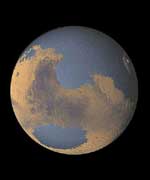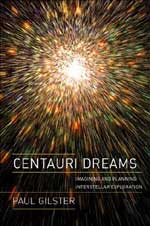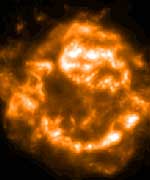A hit TV program like “Antiques Roadshow” lures viewers with its universal appeal. Who wouldn’t want to find secret riches in their attic or basement? But rare paintings and heirloom jewelry aren’t the only valuable items waiting to be discovered. Cosmic treasures also lay hidden in the vast realm of outer space. Among the most highly prized of those treasures are planets that formed around other stars.
Astronomers have just gained an important clue to guide their hunt for extrasolar worlds. And that clue points to the unlikeliest of places – our own backyard.
“It’s possible that some of the objects in our solar system actually formed around another star,” says astronomer Scott Kenyon (Smithsonian Astrophysical Observatory).
How did these adopted worlds join our solar family? They arrived through an interstellar trade that took place more than 4 billion years ago when a wayward star brushed past our solar system. According to calculations made by Kenyon and astronomer Benjamin Bromley (University of Utah) and published in the Dec. 2, 2004, Nature, the Sun’s gravity plucked asteroid-sized objects from the visiting star. At the same time, the star pulled material from the outer reaches of our solar system into its grasp.
“There may not have been an equal exchange, but there was certainly an exchange,” says Bromley.
A Close Brush
Kenyon and Bromley reached this surprising conclusion while working to explain the mystery object Sedna, a world almost as large as Pluto but located much farther from the Sun. Sedna’s discovery in 2003 puzzled astronomers because of its unusual orbit – a 10,000-year-long oval whose closest approach to the Sun, 70 astronomical units, is well beyond the orbit of Neptune. (One astronomical unit, abbreviated A.U., is the average distance between the Earth and the Sun, or about 93 million miles.)
Understanding Sedna is a challenge because its orbit is far away from the gravitational influence of other planets in our solar system. However, the gravity of a passing star can pull objects beyond the orbit of Neptune, in the Kuiper Belt, into orbits like Sedna’s. Kenyon and Bromley have performed detailed computer simulations to show how this stellar fly-by likely took place.
The fly-by must have met two key requirements. First, the star must have stayed far enough away that it did not disrupt Neptune’s nearly circular orbit. Second, the encounter must have happened late enough in our solar system’s history that Sedna-like objects had time to form within the Kuiper Belt.
Kenyon and Bromley suggest that the near-collision occurred when our Sun was at least 30 million years old, and probably no more than 200 million years old. A fly-by distance of 150-200 A.U. would be close enough to disrupt the outer Kuiper Belt without affecting the inner planets.
According to the simulations, the passing star’s gravity would sweep clear the outer solar system beyond about 50 A.U., even as our Sun’s gravity pulled some of the alien planetoids into its grasp. The model explains both the orbit of Sedna and the observed sharp outer edge of our Kuiper Belt, where few objects reside beyond 50 A.U.
“A close fly-by from another star solves two mysteries at once. It explains both the orbit of Sedna and the outer edge of the Kuiper Belt,” says Bromley.
A Crowded Birthplace
But where did such a star come from, and where did it go? Since the fly-by happened more than 4 billion years ago, any suspects have long since escaped the Sun’s neighborhood. There is no practical way to find the culprit today.
The visitor’s origin may seem equally mystifying because the Sun currently lives in a sparse region of the Milky Way. Our closest neighbor is a distant 4 light-years away, and stellar close encounters are correspondingly rare. However, a near-collision would be much more likely for a young Sun if it were born in a dense star cluster, as recent evidence suggests.
“We believe that 90 percent of all stars form in clusters with a few hundred to a few thousand members,” says astronomer Charles Lada (Harvard-Smithsonian Center for Astrophysics). “The denser the cluster, the more likely the chance for an encounter between member stars.”
“This work is an important piece of evidence that the Sun formed in near proximity to other stars,” he adds.
Searching for Adopted Worlds
Kenyon and Bromley’s simulations indicate that thousands or possibly millions of alien Kuiper Belt Objects were stripped from the passing star. However, none have yet been positively identified. Sedna is probably homegrown, not captured. Among the known Kuiper Belt Objects, an icy rock dubbed 2000 CR105 is the best candidate for capture given its unusually elliptical and highly inclined orbit. But only the detection of objects with orbits inclined more than 40 degrees from the plane of the solar system will clinch the case for the presence of extrasolar planets in our backyard.
Kenyon and Bromley’s next goal is to estimate the sky density of captured objects so that they can make a survey to find such adopted worlds.
“In principle, large telescopes like the MMT Telescope [a joint Smithsonian/University of Arizona observatory] can find them if they’re numerous enough,” says Kenyon.
The calculations reported here were made using about 3,000 cpu-days of computer time at the supercomputing center at the Jet Propulsion Laboratory, Pasadena, Calif.
Headquartered in Cambridge, Mass., the Harvard-Smithsonian Center for Astrophysics (CfA) is a joint collaboration between the Smithsonian Astrophysical Observatory and the Harvard College Observatory. CfA scientists, organized into six research divisions, study the origin, evolution and ultimate fate of the universe.
Original Source: Harvard CfA News Release



